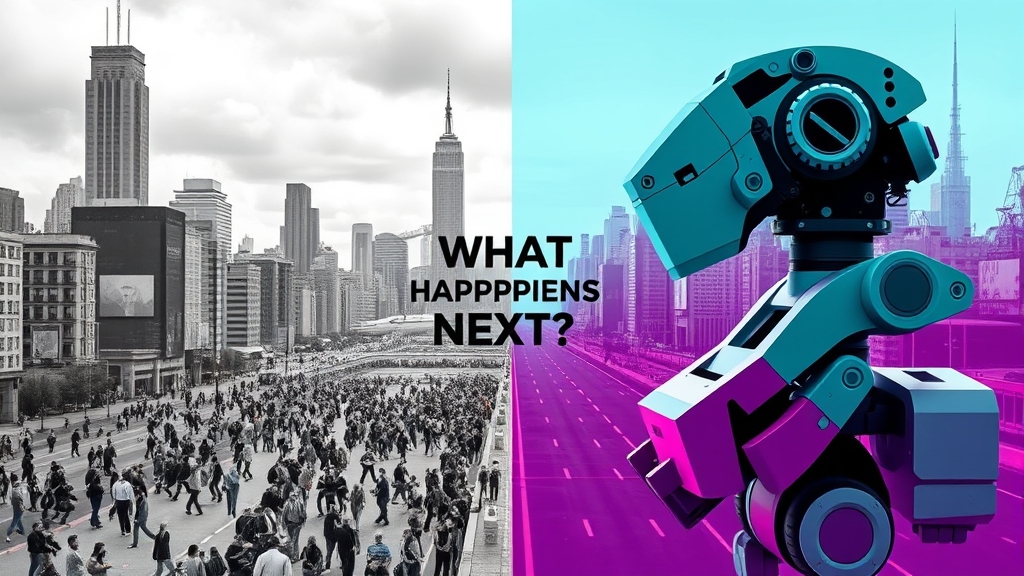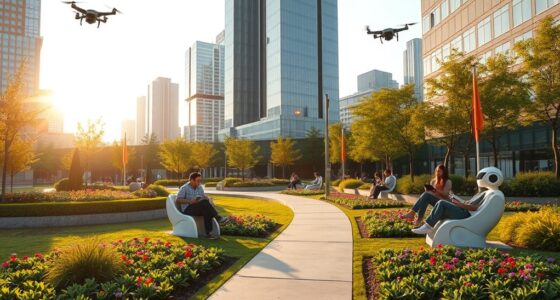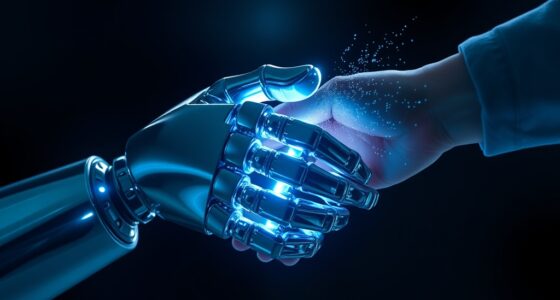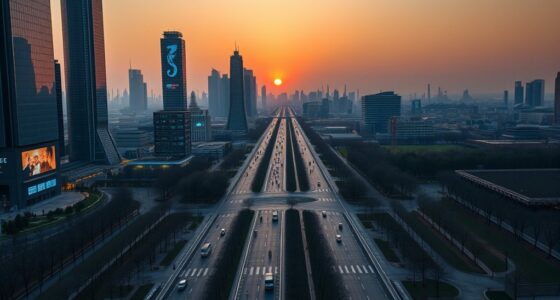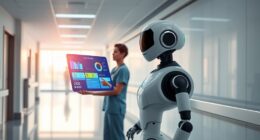What if I told you that your job might disappear within the next decade, not because of economic collapse, but because we’re about to enter an era where human labor becomes optional? We’re standing at the edge of what economists call the post-labor economy, where AI and automation don’t just change how we work—they eliminate the need for most work entirely. In 1953, nearly 98% of prime-age American men worked, and that rate has fallen despite rising output—researchers call this the decoupling of productivity and labor. AI is about to accelerate this trend beyond anything we’ve seen before. So what does a world with optional human labor actually look like? To understand where we’re heading, we need to examine how this disconnect between what we produce and who produces it first began.
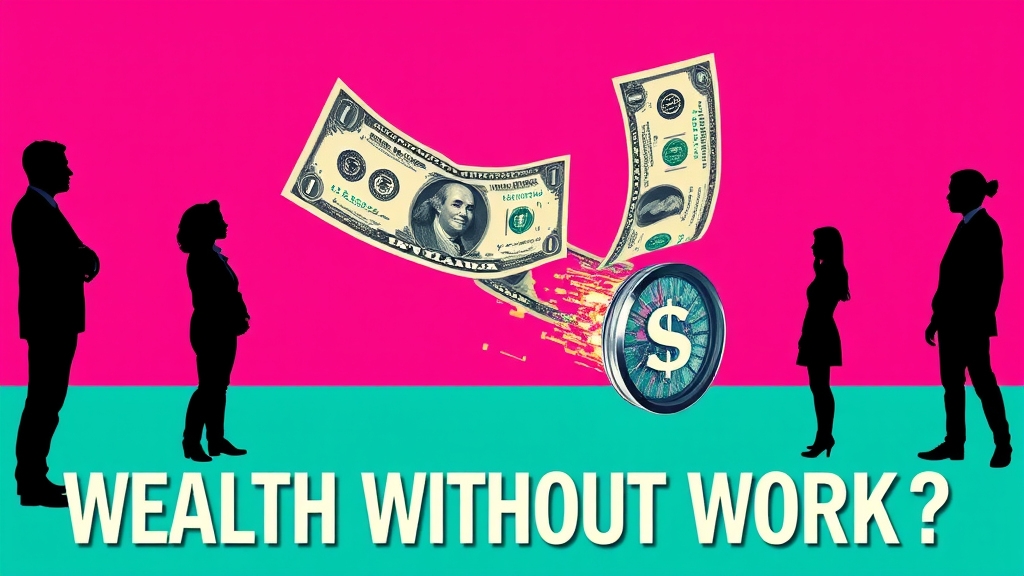
The Great Productivity Disconnect
Since the 1950s, output has surged while headcount fell—a trend now speeding up with AI. Picture two lines on a graph that for over a century moved together like dance partners. One line represents how much stuff we can produce. The other shows how many people we need to produce it. From the Industrial Revolution through the 1940s, these lines stayed remarkably close. More production meant more workers. More workers meant more production. It was the foundation of everything we understood about economics and society.
Then something strange happened in the 1950s. The lines started to separate. We kept producing more cars, more steel, more everything, but we needed fewer people to do it. At first, the gap was small. A factory that once employed 1,000 workers might only need 950. Most people didn’t notice because the economy kept creating new types of jobs. When farm jobs disappeared, factory jobs appeared. When some factory jobs vanished, office jobs multiplied. We convinced ourselves this was just how progress worked.
Here’s what that disconnect looks like in real terms. The Honda plant in Marysville, Ohio, produces over 400,000 vehicles annually with roughly 4,000 workers. In 1985, producing that many cars would have required at least 8,000 people. The remaining workers didn’t become less productive—they became incredibly more productive thanks to robots, computer systems, and automated assembly lines.
We told ourselves this trend would level off. Surely there was a limit to how much we could automate. Machines were good at repetitive tasks, but humans would always be needed for the complex stuff, the creative stuff, the thinking stuff. But the disconnect isn’t slowing down. It’s accelerating exponentially. What took decades to unfold in manufacturing is now happening in months across every sector of the economy. AI systems can now write legal briefs, diagnose medical conditions, and create marketing campaigns. The gap between what we can produce and how many people we need to produce it isn’t just widening—it’s becoming a chasm.

This wave of automation is fundamentally different from anything we’ve experienced before. Previous technological shifts replaced human muscle power. Steam engines could lift heavier loads than people. Assembly lines could manufacture products faster than craftsmen. But humans still provided the brains, the decision-making, the problem-solving. AI changes that equation completely. For the first time in history, we’re creating machines that can think, reason, and make decisions that we once considered uniquely human. AI even won gold at the International Math Olympiad—something experts didn’t expect for years.
What happens when machines can perform most tasks better, faster, and cheaper than humans? If a computer can analyze legal documents more accurately than a lawyer, diagnose illnesses more precisely than a doctor, and write more engaging content than a copywriter, why would businesses continue paying human salaries?
Think about what happened to horses when automobiles arrived. Horses didn’t gradually become unemployed—they became completely obsolete. In 1900, there were over 20 million horses in America providing transportation, power, and labor. By 1960, there were fewer than 3 million, and most of those were for recreation. The horses didn’t retrain for new careers. They didn’t adapt to the changing economy. They simply became unnecessary.
We’re not just talking about individual job losses here. We’re talking about the potential collapse of the entire economic system that’s governed human civilization for centuries. Our economy is built on a simple exchange: people trade their time and effort for money, then use that money to buy goods and services. But what happens when human time and effort become economically worthless?
The signs of this transformation are already everywhere if you know where to look. Customer service chatbots handle millions of inquiries that used to require human representatives. AI systems trade stocks faster and more profitably than human traders. Automated checkout systems eliminate cashier positions. Self-driving trucks are being tested on highways across the country. These aren’t isolated experiments—they’re the leading edge of a massive economic shift.
Here’s what makes this particularly unsettling: productivity gains used to create new opportunities for human work. When the printing press eliminated the need for hand-copying books, it created jobs in publishing, editing, and distribution. When computers automated mathematical calculations, they created new roles in programming, system administration, and data analysis. Each wave of automation opened new doors for human creativity and problem-solving.
AI represents something entirely different. Instead of just replacing human physical capabilities, it’s replacing human cognitive capabilities. It’s not creating new categories of work that only humans can do—it’s systematically eliminating the assumption that humans are necessary for most economic activity.
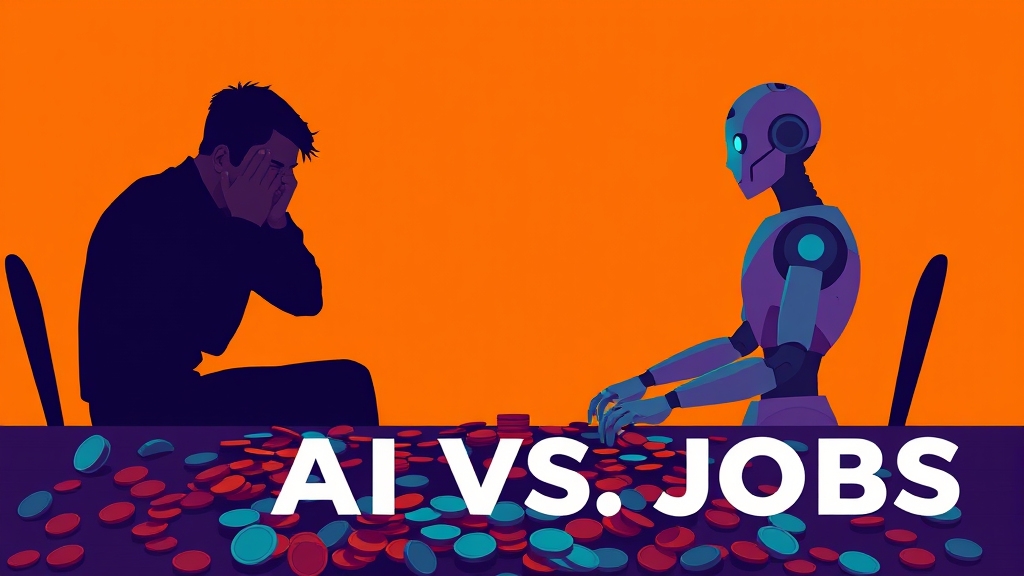
The productivity disconnect that started as a gentle divergence in the 1950s has become an economic earthquake. We’re producing more wealth than ever before, but we’re distributing it among fewer and fewer people who actually contribute labor to create it. The math is straightforward and terrifying: if machines can do most jobs better than humans, and if businesses operate to maximize efficiency and profit, then human workers become a cost to be minimized rather than an asset to be valued.
Now that we see how manufacturing led the shift, let’s examine why AI marks a whole new chapter. The transformation is happening right now, accelerating with each breakthrough in AI capability. Every month brings new examples of tasks we thought were safe from automation being performed better by machines. To understand what makes this moment so different, we need to look at the fundamental ways humans have always contributed economic value—and how AI is systematically attacking each one.
The Four Pillars of Human Value
Imagine four pillars that define why humans matter economically—strength, dexterity, cognition, and empathy. Throughout history, these fundamental capabilities have held up our entire economic system. When machines can do what we do better than we can, those pillars start to crumble.
The first pillar is strength. This one fell centuries ago. Steam engines could lift heavier loads than any human. Factory machines could work longer hours without getting tired. The printing press could produce books faster than armies of scribes copying by hand. But society adapted just fine. When machines took over the heavy lifting, we found new ways to contribute. We became the operators, the supervisors, the maintainers. We learned to work with machines instead of competing against them for raw physical power.
The second pillar is dexterity. This is where things get more interesting. Industrial robots have been chipping away at this advantage for decades, but humans still dominated when it came to fine motor skills and adaptability. Sure, a robot could weld car parts on an assembly line, but could it thread a needle? Could it perform delicate surgery? Could it handle unexpected situations that required quick adjustments? For the longest time, the answer was no. Our hands could do things that machines simply couldn’t match.
But that’s changing fast. The da Vinci Surgical System now performs operations with precision that surpasses human surgeons. These robots can make cuts and sutures with steadiness that human hands can’t achieve. Manufacturing robots can now handle delicate electronics assembly that once required human workers with years of training. What’s even more impressive is that these machines can adapt to variations and unexpected problems in ways that seemed impossible just a few years ago.
The third pillar is cognition. This was the pillar we thought was safely ours. Humans could think, reason, plan, and solve problems in ways machines never could. We had creativity, intuition, and the ability to make connections that seemed to come from nowhere. Even as robots took over physical tasks, we believed our minds would always be our competitive advantage. We built entire career guidance systems around this assumption. Get educated. Learn to analyze. Develop critical thinking skills. Focus on jobs that require human judgment.
That confidence is cracking. AI systems can now write legal briefs that pass professional standards. They can diagnose medical conditions with accuracy that matches or exceeds human doctors. They can create marketing campaigns, write code, and solve complex mathematical problems. ChatGPT can write marketing copy that’s more engaging than what most human copywriters produce. And it does it in seconds, not hours. OpenAI and Google’s AI systems recently achieved gold medals in the International Math Olympiad—a feat experts didn’t expect for another year or two.
The fourth pillar is empathy. This was supposed to be our final frontier. Our ability to understand, connect with, and care for other humans in authentic ways. Machines might be able to crunch numbers and follow instructions, but they could never truly understand human emotions or provide genuine comfort and support. This pillar felt unshakeable because it’s so fundamentally human.
But AI is attacking this pillar too. Digital companions are providing emotional support to elderly patients with promising clinical results. Customer service chatbots are becoming so sophisticated that many people prefer them to human representatives because they’re more patient and consistent. These systems are delivering outcomes that rival human emotional intelligence in controlled settings.
Here’s what makes this moment unprecedented. Previous technological disruptions were different. When the printing press eliminated hand-copying jobs, it created new opportunities in publishing and distribution. When computers automated mathematical calculations, they opened up new roles in programming and system design. Each wave of automation closed some doors but opened others. We always found new ways for humans to add value.
This time feels different because AI isn’t just attacking one pillar at a time. It’s going after three simultaneously. Advanced robotics are handling dexterity. Artificial intelligence is tackling cognition. And AI companions are working on empathy. We’re watching multiple pillars of human economic value crumble at the same time.
If machines become better than us at strength, dexterity, cognition, and empathy, what exactly do we bring to the table? What’s left for humans to contribute that machines can’t do better, faster, and cheaper? This creates a moment of realization that should be deeply unsettling. We’re not just losing one type of work. We’re potentially losing our fundamental economic relevance across all categories of human capability.
What’s happening now represents something that’s never occurred in human history. We’ve always created tools that extended our capabilities or took over specific tasks. But we’ve never created technology that could potentially replace human thinking, human skill, and human connection all at once. We’re not just automating jobs—we’re automating the very qualities that made us economically valuable in the first place.
Three of our four pillars are under attack simultaneously—an economic first. The implications go far beyond individual career concerns. For the first time in human history, we might be creating technology that doesn’t need us at all. The machines won’t just be doing our jobs—they might be doing them better than we ever could. And the speed at which this is happening should make everyone pay attention to what’s building on the horizon.
The Automation Tsunami
We’re standing on a beach right now, watching the water pull back from the shore. Most people see this and think the ocean is just having a quiet moment. But anyone who understands tsunamis knows what’s really happening. That receding water isn’t calm—it’s the buildup before a massive wave crashes down. The automation tsunami isn’t coming anymore. It’s already here, and most of us are still standing on the beach admiring how peaceful everything looks.
Prime-age male employment peaked at 98% in 1953 and is now 89%, our data shows. That might not sound dramatic, but we’re talking about millions of people who simply aren’t needed in the workforce anymore. Manufacturing jobs peaked in 1979 with about 21-22 million employees. Today, American factories employ half that number while producing three times the output. We’re making more stuff with fewer people, and that trend is accelerating across every sector you can imagine.
Manufacturing was just the beginning. The dominoes started falling there because physical automation was easier to implement than cognitive automation. Robots could weld, assemble, and paint faster than humans without taking breaks or demanding benefits. But now the wave is hitting sectors we thought were safe. Transportation is next in line, with self-driving vehicles already being tested on highways across the country. When autonomous trucks hit the road at scale, we’re talking about eliminating millions of driving jobs almost overnight.
Knowledge work is where things get really interesting. AI lawyers are already writing legal briefs that pass professional standards. AI accountants are processing tax returns and financial statements with accuracy that matches human CPAs. AI doctors are diagnosing medical conditions from X-rays and MRIs with precision that rivals specialists with decades of experience. These aren’t experimental prototypes—they’re working systems being deployed right now in real businesses serving real customers.
Here’s what should wake you up: customer service jobs have been decimated by chatbots in just the past two years. Companies like Bank of America report that their AI assistants now handle over 90% of routine customer inquiries. That’s millions of customer service representative jobs that simply don’t exist anymore. Radiologists are facing a similar reality. AI diagnostic tools can now identify tumors, fractures, and other abnormalities from medical images faster and more accurately than human doctors. Many hospitals are already using these systems to supplement or replace human radiologists for routine diagnoses.
Even creative fields aren’t safe anymore. AI can compose music that gets played on streaming platforms. It writes novels that people actually read and enjoy. It creates visual art that sells for thousands of dollars. AI systems are generating video content that’s nearly impossible to distinguish from human-created work. The assumption that creativity was uniquely human is crumbling in real time. These systems aren’t just copying existing work—they’re creating original content that rivals human creativity in both quality and emotional impact.
Why does this keep happening? It comes down to a simple business reality: better, faster, cheaper, safer. AI systems don’t get tired, don’t call in sick, don’t demand raises, and don’t make mistakes due to having a bad day. This isn’t about companies being evil or wanting to hurt workers. It’s about survival in competitive markets. If your competitor can provide the same service at half the cost using automation, you either automate or go out of business. The market doesn’t care about human employment—it cares about efficiency and profit.
The timeline compression is what makes this different from previous industrial revolutions. What took decades during earlier technological shifts is now happening in years or even months. The exponential improvement of AI capabilities means that systems are getting dramatically better at an accelerating pace. Tasks that seemed impossible for machines just two years ago are now routine. This isn’t gradual change—it’s exponential transformation happening in real time.
Recent examples show just how fast this is moving. OpenAI’s models recently achieved gold medal performance in the International Math Olympiad, solving advanced mathematics problems that experts didn’t expect AI to handle for several more years. Google’s AI systems are achieving breakthrough performance in coding competitions, writing software that rivals the work of experienced programmers. These aren’t isolated achievements—they represent systematic improvements across all cognitive domains.
What makes this particularly unsettling is the network effect. As AI gets better, it accelerates its own development. AI systems are now helping to design better AI systems, creating a feedback loop that makes prediction nearly impossible. The pace of improvement isn’t linear—it’s exponential and self-reinforcing. Each breakthrough enables faster progress toward the next breakthrough. We’re not just riding a wave of technological change—we’re caught in an accelerating spiral of AI capability that’s outpacing our ability to adapt.
About 20-30% of Forbes 500 companies are already using generative AI in their operations. Projections suggest that 70-80% will adopt these technologies within the next two to three years. That’s not gradual adoption—that’s a complete transformation of how business gets done in less than half a decade. When major corporations move this fast, the ripple effects hit everyone else almost immediately.
The convergence of AI with humanoid robots and quantum computing creates a perfect storm of automation capability. These aren’t separate technologies developing in isolation—they’re reinforcing each other to create unprecedented automation potential. AI provides the intelligence, robotics provide the physical capability, and quantum computing provides the processing power to make it all work at scale.
Can we change course before the wave crashes? What we’re witnessing goes beyond job displacement. We’re seeing the potential end of human economic necessity across vast sectors of the economy. The traditional assumption that humans are needed to create value is breaking down in real time. Businesses are discovering they can operate more efficiently, more safely, and more profitably with fewer human workers. Some companies are finding they can eliminate entire departments while improving service quality.
This tsunami isn’t something we need to prepare for in the distant future. It’s crashing over us right now. The question isn’t whether this will happen—it’s what happens to society when the fundamental relationship between work and survival gets turned upside down. Because when the wave fully hits, millions of people are going to discover that the economy simply doesn’t need them anymore. What kind of world are we building when human effort becomes truly unnecessary?
When Work Becomes Optional
Imagine work as optional when machines can match our best skills. This isn’t some distant sci-fi fantasy. We’re racing toward a reality where human labor shifts from necessary to optional, and most people haven’t even begun to process what that means. The entire foundation of our society rests on one simple assumption: people need to work to survive. That assumption is about to crumble completely.
Think about how we’ve organized everything around work. Our cities are built around commuting patterns. Our healthcare is tied to employment. Our social security systems depend on payroll taxes. Our sense of self-worth comes from answering the question “What do you do?” We’ve created laws, institutions, and cultural norms that all assume most adults will spend 40-plus hours a week doing something productive that someone else is willing to pay for. What happens when that basic assumption no longer holds?
The economic logic is straightforward and terrifying. If robots and AI can produce everything we need more efficiently than humans, why would businesses hire people at all? Market forces reward efficiency—if machines are cheaper, businesses will deploy them. When a machine can do the same work as ten humans at a fraction of the cost, the choice becomes obvious. We’re talking about basic market forces that make human employment economically irrational.
Here’s the paradox that should keep you awake at night. We’ll have unprecedented abundance of goods and services. Factories will churn out products 24/7 without coffee breaks or sick days. AI systems will provide services with perfect consistency and infinite patience. We could theoretically produce everything humanity needs and wants. But most people won’t have the money to buy any of it because they won’t have jobs. Back-office jobs halved in two decades; output tripled—research shows fewer people power more work. It’s abundance and poverty existing side by side, separated only by an outdated economic system that ties purchasing power to human labor.
History shows us how different this moment really is. When tractors replaced farm workers in the early 1900s, people moved to factories. When factories started automating in the mid-1900s, people moved to service jobs. Each wave of technological change closed some doors but opened others. We always found new places for human workers to add value. But when AI replaces service work, where do people go? What’s the next category of human work that machines can’t do better?
The timeline makes this especially urgent. Previous industrial transitions happened over generations. Your grandfather might have been a farmer, your father worked in a factory, and you work in an office. Each generation had time to adapt and retrain. But we’re looking at a transition that could happen within a single decade. The pace of AI improvement means that jobs could disappear faster than people can retrain for new ones. We’ve never experienced this level of disruption in such a short amount of time.
This isn’t just about jobs—your community ties, your purpose, even how you answer “What do you do?” are on the line. For most people, work provides identity, purpose, and social structure. It answers fundamental questions about who you are and what you contribute to the world. When someone asks what you do, they’re really asking who you are. Work gives you a reason to get up in the morning, people to interact with during the day, and a sense of accomplishment when you go home. What happens when all of that disappears? How do you maintain purpose and identity when society no longer needs your contribution?
Work also provides what economists call “economic agency” – the ability to influence your economic fate. Right now, you can work harder, get better skills, or change jobs to improve your situation. You have some control over your economic destiny through your labor. But automation erodes that agency completely. When machines can do your job better than you can, working harder doesn’t help. Getting more education doesn’t matter if AI can outperform human experts. Your economic fate becomes completely disconnected from your effort or ability.
We’re facing a stark choice that will define the next century. Either we find new ways to distribute wealth and opportunity, or we face massive social upheaval as the majority of people become economically irrelevant. There’s no middle ground here. You can’t have a functioning society where most people have no income and no economic purpose while a small group of capital owners controls all the wealth and productive capacity.
Let’s make this concrete. Imagine you’re an accountant, and AI systems start handling tax preparation, bookkeeping, and financial analysis better than humans. Your job disappears, but you still need to pay rent, buy groceries, and support your family. The economy is humming along just fine without you – maybe even better than before. But you have no way to participate in that prosperity because you have nothing to sell that anyone wants to buy. Multiply that scenario by millions of people across dozens of professions, and you get a sense of the social crisis we’re heading toward.
Teachers face the same reality as AI tutoring systems become more effective than human instruction. Doctors will find AI diagnostic tools that outperform human expertise. Even lawyers aren’t safe as AI legal research and brief writing becomes standard practice. These aren’t entry-level jobs we’re talking about. These are careers that require years of education and training, and they’re all vulnerable to AI automation within the next decade.
The challenge isn’t just economic – it’s existential. We need to fundamentally reimagine how society works when work itself is no longer the primary way people contribute to or benefit from the economy. This means rethinking everything from how we distribute wealth to how we find meaning and purpose in our lives. It means questioning assumptions about human value that have been constant throughout all of recorded history.
What does this mean for you right now? It means the career advice you’ve been following – get educated, work hard, develop valuable skills – might be completely wrong for the world we’re entering. The skills that make you valuable today could become worthless tomorrow as AI capabilities expand. The question isn’t whether this will happen. The question is whether we’ll adapt our economic and social systems in time to handle the transition, or whether we’ll cling to outdated assumptions until the whole system breaks down under the weight of its own contradictions.
But there’s something even more fundamental at stake here that most people haven’t considered. The very source of workers’ power throughout history is about to disappear completely.
The Death of Labor Power
Throughout history, workers had power for one simple reason: they could withdraw their labor and bring the economy to a halt. Every strike, every union negotiation, every demand for better working conditions relied on this basic fact. Businesses needed workers more than workers needed any specific job. That fundamental dynamic gave ordinary people leverage against capital owners, corporations, and even governments. But what happens when human labor becomes optional?
Strikes only mattered because production stopped—automation removes that leverage. When factory workers walk off the job, production stops. When teachers strike, schools close. When truckers refuse to drive, goods don’t get delivered. The entire system of collective bargaining depends on the threat that workers can shut down operations by simply not showing up. This leverage has been the foundation of worker rights for over a century. But automation doesn’t just eliminate jobs. It eliminates workers’ fundamental source of power in society.
History shows us how labor scarcity creates worker power. During the Black Death in Europe, the massive loss of life created a labor shortage that significantly increased the bargaining power of peasants. This scarcity led to higher wages and improved working conditions, demonstrating the direct link between the necessity of human labor and worker influence. When workers were scarce, they could demand better treatment because employers had no choice but to meet their demands or face economic collapse.
Conversely, when labor becomes abundant, worker power disappears. In 1800, about 80% of Americans worked in agriculture. By 2000, that number had dropped to just 2%. As farming became mechanized, individual farm workers lost their ability to negotiate because they could be easily replaced by machines or other workers. This pattern shows how technological advancement systematically erodes the scarcity that gives workers leverage.
Now imagine trying to negotiate better working conditions when your employer can simply replace the entire workforce with machines. Picture a factory where robots handle all the production, AI systems manage logistics, and automated quality control ensures perfect output. When workers strike, production doesn’t stop. It might actually improve because machines don’t have bad days, don’t get tired, and don’t make mistakes due to personal problems. The strike becomes irrelevant because the business can function perfectly well without human workers.
When labor is optional, the political bargain linking work and influence unravels. Democratic systems have traditionally balanced the interests of capital and labor because both were necessary for economic success. Politicians had to consider worker concerns because angry workers could damage the economy through strikes, slowdowns, or simply refusing to participate. But when the economy can function without significant human labor, that political calculation changes completely.
As capital becomes more important than labor, those who own the robots and AI systems gain unprecedented control over society. This isn’t just about having more money. It’s about controlling the means of production in a way that makes human contribution unnecessary. When a small group of people owns all the productive capacity and everyone else has nothing to offer that can’t be done better by machines, we’re looking at a concentration of power unlike anything in human history.
The social contract that has governed civilized society for centuries is breaking down. That contract was simple: workers exchange labor for a share of prosperity. You work, you get paid, you participate in the economic benefits that your work helps create. But this deal only works when labor is actually needed. When machines can do everything better than humans, what do workers have to offer in exchange for their share of prosperity?
Think about what economic agency means. It’s your ability to influence your economic fate through your own actions. Right now, you can work harder, get better skills, change jobs, or start a business to improve your situation. You have some control over your economic destiny because your labor has value. But automation erodes that agency completely. When machines outperform humans in every category, working harder doesn’t help. Getting more education becomes pointless if AI can outperform human experts. Your economic fate becomes disconnected from your effort or ability.
We might be creating a world where a small group of capital owners have all the power while everyone else has no economic leverage whatsoever. This isn’t just inequality. It’s a fundamental shift in the nature of power itself. Throughout history, even the poorest workers had something valuable to withhold. Their labor might not have been worth much individually, but collectively it was essential. That gave them at least some bargaining power, some voice in how society was organized.
What happens when that voice disappears completely? When the primary source of worker power – the ability to withhold labor – is eroded by automation, the traditional mechanisms for distributing wealth and power are disrupted. The checks and balances that have prevented extreme concentration of power throughout history stop working when one side of the equation becomes completely unnecessary.
This shift necessitates exploring new frameworks for maintaining economic agency in a post-labor economy. Without labor rights as a foundation, we need to strengthen property rights and democratic rights, and potentially develop entirely new concepts like algorithmic rights or data rights. But these alternatives require deliberate policy choices and social restructuring. They won’t emerge naturally from market forces that are optimizing for efficiency rather than human welfare.
As workers lose this power, what replaces the strike is not clear. The stark reality is that we’re racing toward a future where the fundamental source of worker power throughout all of human history simply disappears. When labor becomes optional, so does everything that depended on labor having value. That includes not just jobs and wages, but the entire framework that determined how wealth gets distributed in the first place.
Three Sources of Income
To understand what happens next, we need to examine where money actually comes from. Every dollar that flows into households arrives through one of three channels: wages from work, returns from property, and transfers from government. That’s it. These three sources account for virtually all household income across developed economies. Understanding this breakdown becomes crucial when you realize that automation is about to completely disrupt the biggest slice of that pie.
Let’s break down the current reality with some hard numbers. About 60% of household income comes from wages, 20% from property, and 20% from government transfers. People work jobs, collect paychecks, and use that money to pay for housing, food, and everything else they need. Another portion comes from owning things like stocks, real estate, businesses, or other investments that generate returns. The final portion arrives through government programs like Social Security, unemployment benefits, welfare, and other transfer payments. This distribution has remained relatively stable for decades, creating the illusion that wage-based income will always dominate.
But what happens when that biggest slice starts shrinking rapidly due to automation? We’re not talking about a gradual adjustment over generations. The pace of AI development suggests this shift could happen within a single decade. When wages drop from 60% to 40% to 20% of household income, millions of families face an immediate crisis. They can’t just magically start earning investment returns or qualify for government programs overnight. The math becomes brutal for anyone who depends primarily on selling their labor.
This creates a dangerous economic spiral that feeds on itself. Fewer jobs mean less consumer spending because people without wages can’t buy things. Less consumer spending means companies automate even more to cut costs, accelerating job displacement.
Here’s the mathematical problem that should terrify policymakers. If wages disappear but we don’t dramatically increase property ownership or government transfers, most people will have no income at all. You can’t just tell someone whose job got automated to “go earn investment returns” when they don’t own any investments. You can’t expect them to live on government transfers when those programs aren’t designed to support the majority of the population. The current system assumes most people earn wages, but that assumption is breaking down in real time.
Let’s make this concrete with an example that reflects the broader pattern of job displacement we’re seeing. Imagine Sarah, a marketing manager who makes $75,000 annually. Her job gets replaced by AI systems that can create better campaigns at a fraction of the cost. Sarah’s primary income source disappears overnight. She has maybe $10,000 in a retirement account that might generate $400 per year in returns. She doesn’t qualify for most government programs because they’re designed for people with no assets at all. Sarah goes from comfortable middle-class life to financial crisis not because she did anything wrong, but because the economy no longer needs her contribution. Her situation mirrors what researchers have documented about the “missing millions” – prime-age workers who have simply dropped out of the labor force as their industries automated or moved offshore.
Multiply Sarah’s situation by millions of people across dozens of professions, and you get a sense of the economic disruption heading our way. Teachers, accountants, lawyers, doctors, and countless other professionals face similar scenarios as AI capabilities expand. These aren’t minimum-wage workers we’re talking about. These are educated, skilled professionals who followed all the traditional advice about building careers and contributing to society. None of that matters when machines can do their jobs better.
The wealth concentration effect makes this transition even more problematic. As returns to capital increase and returns to labor decrease, money flows increasingly to those who already own assets. People who own stock in companies benefit when those companies become more profitable through automation. People who own real estate benefit when property values rise due to increased productivity. But people who only own their labor watch their economic value evaporate. This isn’t just inequality growing gradually. It’s a systematic transfer of economic power from workers to capital owners happening at unprecedented speed.
Labor’s share of income has already been declining for decades. Globally, it dropped from approximately 56% fifty years ago to just over 52% today. That might not sound dramatic, but it represents a massive shift in how wealth gets distributed. We’re approaching the point where less than half of all income comes from labor. Automation will accelerate this trend until labor’s share becomes virtually negligible. Most people haven’t processed what it means to live in an economy where human work contributes almost nothing to overall wealth creation.
The transition timeline creates unique policy challenges. This shift from a wage-based to capital-based economy could happen faster than society can adapt. Previous economic transitions took generations, giving people time to retrain, relocate, and adjust their expectations. But AI capabilities are improving exponentially, not linearly. Skills that seem secure today could become worthless within five years. Educational systems, social programs, and financial institutions aren’t designed to handle this pace of change.
How do you maintain consumer demand and social stability when the primary source of income for most people is disappearing? This isn’t just an economic question. It’s a fundamental challenge to social cohesion. Democracy assumes that citizens have economic stakes in society that give them legitimate political interests. When most people contribute nothing to production and depend entirely on transfers or capital ownership they don’t control, the foundation of democratic participation erodes.
The policy implications are enormous. Governments will need to choose between massive expansion of transfer programs, dramatic redistribution of property ownership, or acceptance of mass economic irrelevance for most citizens. Each option requires unprecedented political will and social transformation. Expanding government transfers means figuring out how to fund payments to potentially hundreds of millions of people. Redistributing property ownership means challenging the fundamental assumptions of capitalism. Accepting mass economic irrelevance means accepting social instability on a scale that could threaten civilization itself.
Here’s the core insight that changes everything: surviving the post-labor economy requires fundamentally changing how wealth is distributed across these three categories. We can’t just hope the market will sort this out naturally. Market forces optimize for efficiency, not human welfare. Without deliberate intervention, we’re heading toward an economy where a small group of capital owners captures all the benefits of automation while everyone else gets nothing. So how do we refill the shrinking wage slice? Let’s look at policy debates and ownership models.
The Universal Basic Income Debate
Universal Basic Income has become the most talked-about solution to post-labor economics, but here’s why it’s far more complicated than most people think. The vision sounds appealing enough. Everyone receives money from the government to cover basic needs like food, housing, and healthcare. You’re freed from the requirement to work for survival. You can pursue education, start a business, care for family members, or follow creative passions without worrying about paying rent. It’s economic freedom in its purest form, breaking the link between survival and selling your labor to someone else.
But the fundamental questions reveal just how complex this gets. Who pays for it? If we’re giving every adult citizen enough money to live on, we’re talking about trillions of dollars annually. How much should it be? A basic survival amount might prevent homelessness but won’t stimulate economic growth. A generous amount might cost more than entire government budgets. What happens to incentives to work and innovate? If people can live comfortably without jobs, will they still choose to contribute to society in productive ways?
Real-world evidence from pilot programs offers some answers, but also raises new concerns. Stockton gave $500 monthly and saw stability gains—but costs trillions if scaled nationally. Participants showed improvements in financial stability and mental health. They used the money primarily for necessities like food and utilities, not luxury items or vices as critics predicted. Similar programs in Finland and Kenya produced comparable results. People became more stable, not lazier. They had more time to search for better jobs or pursue education.
However, these pilot programs also highlighted significant limitations. They were temporary, small-scale, and existed within broader economies where most people still worked traditional jobs. The psychological and economic effects might be completely different when UBI becomes permanent and universal. When everyone receives basic income rather than just a small test group, the entire economic landscape changes in ways that small pilots can’t predict.
Economists warn that injecting cash without boosting supply can stoke price increases. If you give everyone money but don’t increase the supply of goods and services, prices might just rise to absorb the extra cash. Imagine if every American suddenly received an extra $1,000 monthly. Landlords might raise rents by $300. Grocery stores might increase food prices. Car dealers might bump up their rates. The UBI could get eaten up by inflation, leaving people no better off than before.
The core question—how to fund UBI without disincentivizing innovation—is still unresolved. American culture particularly ties personal value to productivity and employment. The idea of giving money to people who don’t work triggers deep-seated beliefs about fairness and personal responsibility. Even people who might benefit from UBI often oppose it because they’ve internalized the message that receiving money without working is somehow morally wrong.
The automation paradox creates complex economic feedback loops that nobody fully understands yet. UBI might be funded by taxing the very automation that eliminates jobs. Companies that replace human workers with robots could face higher tax rates to fund payments for displaced workers. But this creates incentives that could slow beneficial automation or encourage companies to relocate to countries without robot taxes. The economic relationships become so interconnected that predicting outcomes becomes nearly impossible.
Implementation presents its own set of challenges. The transition period could be chaotic, with some people receiving UBI while others still depend on disappearing jobs. How do you phase in a universal program without creating massive disruption? Do you start with unemployed people? Recent graduates? Entire geographic regions? Each approach creates different problems and political tensions. People still working might resent supporting those receiving UBI, especially if their own jobs feel threatened by automation.
Different UBI models have dramatically different implications for society. Basic survival amounts might prevent homelessness and hunger but won’t stimulate economic growth or innovation. More generous universal high income proposals could provide real economic freedom but would cost enormous amounts and potentially reduce work incentives significantly. Some proposals include universal basic services instead of cash payments, providing free healthcare, education, and transportation rather than money. Each model requires different funding mechanisms and creates different social dynamics.
The funding question becomes particularly complex when you consider the scale involved. Providing every American adult with $12,000 annually would cost roughly $3 trillion, nearly the entire federal budget. Funding mechanisms could include carbon taxes, financial transaction taxes, wealth taxes on large concentrations of capital, or taxes specifically on automation and AI systems. Each approach has different economic effects and political feasibility. The choice of funding mechanism might matter more than the UBI amount itself.
Here’s what makes this especially challenging. UBI alone might not be enough to address the complexities of a post-labor economy. It might need to be part of a much larger transformation of how we think about work, value, and human worth. UBI could provide basic security, but people also need purpose, community, and ways to contribute meaningfully to society. Without addressing these deeper needs, UBI might create a stable but psychologically unsatisfying existence for millions of people.
The success of UBI depends on its integration with other policies that promote economic equity and social well-being. This could include job guarantee programs, universal basic services, worker ownership initiatives, and education reforms. The goal isn’t just to provide income replacement for lost jobs. It’s to create a society where individuals can thrive regardless of their employment status while maintaining incentives for innovation and social contribution.
What does this mean for the post-labor transition? UBI represents one possible solution, but it’s not a magic fix for the economic disruption ahead. The version that gets implemented, how it gets funded, and what other policies accompany it will determine whether it helps society adapt to automation or just postpones the reckoning with more fundamental changes needed in how we organize economic life. Could a hidden alternative address UBI’s shortcomings? The debate over UBI is really a debate over what kind of society we want to create when human labor becomes optional rather than necessary.
Beyond UBI: The Ownership Revolution
What if instead of waiting for government handouts, we gave everyone ownership stakes in the automated economy itself? Rather than fighting against the machines that are taking jobs, everyone gets to own part of those machines. When a factory installs robots that eliminate human workers, those workers don’t just lose their jobs. They become shareholders in the automated system that replaced them. When AI takes over customer service, the displaced workers own stakes in the AI companies providing those services. Imagine owning stakes in the AI systems that replace you—just like Alaskans own oil revenue.
The concept is called universal basic capital, and it flips the entire automation debate on its head. Instead of receiving charity from the government, people would own shares in the robots, AI systems, and companies that are replacing human workers. You wouldn’t just get money. You’d get a piece of the action. The more productive the automation becomes, the more money flows to the people who own it.
Alaska already proves this can work with their Permanent Fund. Every resident receives roughly $1,700 annually from oil revenues, demonstrating that resource-based wealth sharing actually functions in the real world. The state takes a portion of oil profits and distributes them directly to citizens. It’s not welfare or charity. It’s ownership. Alaskans own their natural resources collectively, and they benefit when those resources generate value. This model has operated successfully for decades without creating dependency or reducing work incentives.
Now imagine expanding that concept to the digital age. What if governments owned stakes in major tech companies and distributed the profits to citizens? Instead of letting a few billionaires capture all the benefits of AI development, sovereign wealth funds could hold shares in Google, Microsoft, and OpenAI. When these companies become more profitable through automation, citizens receive quarterly dividends just like any other shareholder. The more successful the AI revolution becomes, the more money flows to ordinary people who collectively own part of it.
Employee ownership models offer another concrete path toward this vision. Cooperatives like REI already distribute dividends to members based on their purchases. Employee stock option plans give workers stakes in the companies they help build before automation takes over. These aren’t theoretical concepts. They’re working systems that could be expanded dramatically. Imagine if every major corporation was required to distribute a significant portion of ownership shares to their employees before implementing large-scale automation. Workers would have a financial incentive to support technological progress rather than resist it.
The psychological advantages of ownership go far beyond the financial benefits. Owning part of the economy feels fundamentally different from receiving charity. It maintains dignity and creates incentives for engagement rather than dependence. When you own shares in automated systems, you want those systems to succeed. You become an advocate for innovation rather than a victim of technological change. You have a voice in how businesses operate because you’re a stakeholder, not just a recipient of government assistance.
But how do you transition from a system where capital is privately owned to one where ownership is more broadly distributed? The implementation challenges are enormous. Current shareholders won’t voluntarily give up their stakes just to help society adapt to automation. Governments would need to use tax policy, regulation, or direct investment to gradually shift ownership patterns. This might involve creating public investment funds that purchase shares in major corporations and distribute the returns to citizens. It could mean requiring companies to issue new shares to workers before implementing automation.
Let’s make this concrete with some examples. Imagine receiving quarterly dividends from your stake in the automated factories that produce your consumer goods. Picture getting payments from the delivery robots that bring packages to your neighborhood. Think about owning shares in the AI systems that provide customer service for your local utilities. These wouldn’t be government payments funded by taxes. They’d be investment returns from your ownership stakes in the productive assets of the economy.
The democratic implications of widespread ownership are profound. If everyone owns part of the economy, everyone has a voice in how it’s run and how the benefits are distributed. Shareholders get to vote on corporate policies. They can influence executive compensation, environmental practices, and automation strategies. When ownership is concentrated among a few wealthy individuals, those individuals control economic decision-making. When ownership is distributed broadly, economic democracy becomes possible in ways that traditional political democracy alone cannot achieve.
This approach could leverage new technologies to create entirely new forms of collective ownership. Wisconsin recently legalized Decentralized Autonomous Organizations, while Estonia uses blockchain for direct democracy and digital identity systems. These technologies could enable new forms of economic participation that don’t depend on traditional corporate structures or government programs. Blockchain-based platforms offer collective decision-making that is both permissionless and transparent.
Consider how this changes the entire narrative around AI and automation. Instead of fearing job displacement, people could anticipate the financial returns from more efficient automated systems. Instead of resisting technological change, communities could advocate for faster adoption of productivity-enhancing technologies. The economic incentives align perfectly with social benefits when everyone owns part of the automated economy.
The transition will require massive changes in tax policy, corporate law, and financial regulations. But the basic principle is simple and proven. When people own productive assets, they benefit from increases in productivity. When they don’t own anything, they get left behind as automation makes those assets more valuable. The choice isn’t between capitalism and socialism. It’s between concentrated ownership and distributed ownership within a market system that rewards innovation and efficiency.
This ownership revolution represents the best hope for maintaining both economic prosperity and social cohesion as we enter the post-labor age. Rather than creating permanent dependence on government transfers, it creates permanent stakes in economic success. Rather than fighting against technological progress, it aligns human interests with the march of innovation. The possibilities are enormous when everyone gets to own part of the future rather than just hoping someone else will take care of them.
But understanding these big-picture solutions is only part of the equation. While policymakers debate universal basic income and ownership models, the economic transformation is already underway.
Preparing for the Transition
What can you actually do right now to prepare for this economic shift? The future might be uncertain, but there are concrete steps you can take today that will position you better regardless of how the post-labor transition unfolds. Think of this as building multiple safety nets while the old system still works, so you’re ready when it doesn’t.
Start with the skills that will be hardest for AI to replicate in the near term. Communication sits at the top of this list. We’re not just talking about being able to write emails or give presentations. We’re talking about negotiation, conflict resolution, coaching, and the ability to connect with people in meaningful ways. These skills transfer across industries and remain valuable even when specific job functions get automated. Whether you’re explaining complex ideas to confused customers, mediating disputes between team members, or helping someone work through personal challenges, communication creates value that AI struggles to match.
Empathy follows close behind as the second critical skill. Machines can generate content and analyze patterns, but they can’t understand the deeper human motivations that drive real innovation. They can’t read a room and adjust their approach based on subtle social cues. They can’t provide the kind of genuine understanding that helps people feel truly supported. Focus on developing these capabilities through deliberate practice. Take on projects that require creative problem-solving. Put yourself in situations where you need to understand and respond to human emotions. These skills align with what psychologists call self-determination theory – the human need for competence, autonomy, and relatedness – which gives them lasting value even as automation advances.
But skills alone won’t protect you if your only income comes from selling those skills to an employer. You need to build multiple income streams right now, while traditional employment still provides a foundation to work from. Consider stock-market matching similar to 401(k) matches, as suggested by policy experts. This approach leverages existing employer benefits while building ownership stakes in the broader economy. The goal isn’t to get rich quick. It’s to create financial resilience that doesn’t depend entirely on someone else deciding your work is worth paying for.
Financial literacy becomes crucial when wages might disappear entirely. Understanding how investments work, how compound interest builds wealth over time, and how to evaluate different asset classes will determine whether you benefit from the post-labor economy or get left behind by it. This isn’t just about stock picking or real estate investing. It’s about understanding how money flows through the economy and positioning yourself to capture some of that flow through ownership rather than just labor.
Community building deserves attention because local networks offer resilience when mass layoffs hit. Strong relationships provide opportunities for collaboration, mutual support, and access to resources that might not be available through formal channels. They also create resilience against economic shocks that could devastate people who are isolated and dependent on distant institutions. Invest time in building genuine connections now, before you need them. Participate in local organizations, attend community events, and look for ways to contribute value to the people around you.
Entrepreneurial opportunities still exist in areas where humans provide unique value. Look for services and experiences that people will continue to want from other humans even when machines can technically do the work. Personal training, life coaching, artisanal crafts, local entertainment, and customized services all have potential because they involve human connection and personalization that many people prefer over automated alternatives.
The key is identifying needs that automation might actually create rather than eliminate. As life becomes more digital and automated, some people will pay premiums for authentic human experiences. As AI handles more routine decisions, people might value human judgment and creativity even more highly. As work becomes optional, people might need more help figuring out how to find purpose and structure their time productively.
Here’s the mindset shift that changes everything. Stop thinking about job security and start thinking about economic agency. Job security assumes you’ll work for someone else for decades and they’ll take care of you. Economic agency means building multiple sources of value and income so you’re not dependent on any single employer or even any single type of work. It means owning assets that generate returns, developing skills that create value across different contexts, and building relationships that open up opportunities you can’t predict in advance.
This transition from employee thinking to owner thinking requires changing how you view your relationship with the economy. Instead of just selling your time for money, you’re building systems that create value over time. Instead of depending on a single employer for all your income, you’re creating multiple revenue streams that provide stability through diversification. Instead of hoping someone else will take care of your economic future, you’re taking active responsibility for building wealth and opportunity.
Humans have successfully navigated major economic transitions before. We adapted from hunting and gathering to agriculture. We transitioned from agricultural to industrial economies. We shifted from manufacturing to service work. The same flexibility and creativity that got us through previous changes will be essential now, but the pace of change means we need to be more deliberate and proactive about preparing for what’s coming.
Start building your portfolio and skills today—economic agency beats job security in a post-labor world. Those who understand what’s happening and prepare accordingly will be positioned to thrive in the new economy rather than just survive it. The transition will be challenging, but it also represents unprecedented opportunities for people who are ready to think differently about work, value, and economic participation. Yet individual preparation alone won’t determine how this transformation unfolds. The biggest decisions about our economic future are being made in government offices and corporate boardrooms right now.
The Policy Battleground
Three critical policy battles will determine whether automation creates shared prosperity or concentrated wealth. The decisions being made in legislative chambers over the next decade will shape whether the post-labor transition benefits everyone or just a select few. These aren’t abstract debates happening in distant capitals. They’re concrete policy choices that will directly affect your economic future and your community’s stability.
Robot taxes represent the first major battleground. The concept is straightforward: when companies replace human workers with machines, they should contribute to supporting the displaced workers and maintaining social programs. South Korea already implemented a limited version by reducing tax incentives for automation investments. The European Union is actively debating broader robot tax proposals. But tech companies are pushing back hard, arguing that taxing automation will slow innovation and make their countries less competitive globally. They prefer the current system where they capture all the productivity gains while society bears the costs of unemployment and social disruption.
Data ownership rights create the second crucial policy fight. AI systems become smarter by analyzing massive amounts of human-generated data from our online activities, purchases, and interactions. When that data gets used to train systems that replace our jobs, shouldn’t we receive compensation? Some proposals would treat personal data like property, giving individuals the right to license their information and receive payments when it’s used commercially. Others suggest collective data ownership through public trusts that could negotiate on behalf of citizens. Tech companies oppose both approaches, preferring the current system where they collect our data for free and keep all the profits from AI systems trained on it.
Wealth redistribution through sovereign funds represents the third and perhaps most important policy debate. Alaska’s Permanent Fund already demonstrates how this works by distributing oil revenues to residents. Several countries are considering similar approaches for the digital economy. Norway’s massive sovereign wealth fund could serve as a model for capturing automation profits and distributing them to citizens. The idea is simple: governments invest in the companies and technologies driving automation, then share the returns with everyone rather than letting a few billionaires capture all the benefits.
Estonia’s blockchain democracy initiatives show how technology could help citizens participate more directly in these complex policy decisions. Their digital voting systems and online citizen engagement platforms provide models for making decisions about AI and automation with broader public input. Switzerland’s referendums on universal basic income, while unsuccessful so far, generated valuable public discussion about alternative economic models and showed how democratic processes can address post-labor economics.
These policy experiments matter because countries that figure out post-labor economics first will gain massive advantages. Nations that successfully navigate this transition will attract investment, retain talented workers, and maintain social stability while their competitors struggle with unemployment and political unrest. This creates intense pressure for rapid policy experimentation as governments realize they can’t afford to wait and see what happens.
The political landscape complicates everything. Tech companies employ armies of lobbyists who understand exactly how proposed regulations would affect their business models. They craft compelling arguments about innovation and economic growth while downplaying the risks to workers and communities. Meanwhile, labor advocates fight for worker protections that might become completely irrelevant when human labor isn’t necessary. These competing interests create a challenging environment for rational policy decisions when the fundamental nature of work changes faster than political systems can adapt.
Local governments might actually lead the way while federal governments get stuck in partisan gridlock. Cities and states have more flexibility to experiment with new approaches and can respond more quickly to changing economic conditions. Some cities are already testing universal basic income programs for residents. Others are experimenting with public banks that could fund worker ownership initiatives. State governments are considering different approaches to taxing automation and supporting displaced workers.
The timeline makes action urgent. AI capabilities improve exponentially, not gradually. Policy decisions that seem reasonable today might be completely inadequate for the economic reality of five years from now. But policies take years to design, pass, and implement. Waiting for perfect information might mean missing the window to shape the transition while it’s still manageable.
You can shape policy by voting on local pilot programs and contacting representatives about automation policies. Your voice in these decisions matters more than you think, especially at local and state levels where individual participation has greater impact. The policies that get enacted will determine whether you benefit from automation or get left behind by it. They’ll decide whether your community thrives during the economic transition or struggles with unemployment and social instability.
This isn’t about supporting particular political parties or candidates. It’s about understanding that the biggest economic transformation in human history is happening right now, and the policy responses we choose will determine how that transformation affects everyone’s lives. The future won’t just happen to us. It will be shaped by the decisions we make collectively about how to handle the opportunities and challenges ahead.
Get involved now—your community’s future depends on these policy choices. But beyond the immediate policy battles and economic disruptions, there’s a bigger picture that deserves our attention.
The Age of Abundance
What if everything we’ve discussed about economic disruption and job displacement is actually leading to something extraordinary? Picture a world where the post-labor transition succeeds beyond our wildest expectations. This isn’t just about surviving automation. This is about creating an age of unprecedented prosperity and human flourishing that makes our current economic struggles look like growing pains before a massive breakthrough.
Let’s start with the production possibilities. Once cognitive abundance arrives, marginal costs approach zero—researchers call this cognitive hyperabundance. When AI and robots can manufacture anything we need at near-zero marginal cost, scarcity becomes a choice rather than a constraint. Think about what this means for food production efficiency. Automated farming systems could produce nutritious meals at costs so low that hunger becomes a distribution problem, not a production problem. We’re not talking about rationing or making do with less. We’re talking about abundance so complete that the economic limitations that have defined human civilization for millennia simply disappear.
Imagine having complete control over your schedule without the pressure of earning survival money. You wake up when you want, spend time with people you care about, and pursue activities that genuinely interest you. This isn’t retirement at 65 after decades of grinding through jobs you tolerated. This is time liberation starting whenever the automated economy can support it. You could spend years learning new skills just because they fascinate you. You could travel extensively, not as brief escapes from work, but as extended explorations of places and cultures that capture your imagination. You could start projects, abandon them if they don’t work out, and try something completely different without worrying about paying rent.
This time freedom creates conditions for a creativity explosion unlike anything in human history. When people don’t need to work for money, they can focus on art, science, philosophy, and innovation for their own sake. Think about all the potential artists, inventors, and thinkers who never pursued their talents because they needed stable paychecks. How many breakthrough discoveries are locked away in people who spent their lives in jobs that didn’t utilize their best capabilities? How much incredible art goes uncreated because creative people can’t afford to take risks with their time? The post-labor economy unlocks all of that human potential by removing the economic barriers that force people into careers based on survival rather than passion.
A world where human intelligence gets freed from routine tasks could tackle challenges like climate change and disease with unprecedented focus. Right now, brilliant minds spend their time optimizing ad targeting algorithms or finding new ways to encourage consumer spending. Imagine redirecting that intellectual firepower toward solving humanity’s biggest problems. Climate scientists could spend years developing solutions without worrying about research funding. Medical researchers could pursue long-term projects without pressure to generate quick commercial results. Social innovators could experiment with new ways of organizing communities and relationships without needing to monetize their efforts immediately.
The community renaissance potential excites me more than almost any other aspect. Stronger local connections, more time for civic engagement, and deeper relationships become possible when work no longer dominates life. You have time to know your neighbors, participate in local decision-making, and contribute to your community in meaningful ways. Parent-child relationships improve when parents aren’t exhausted from long commutes and demanding jobs. Friendships deepen when people have energy and time to invest in them. Civic organizations flourish when volunteers don’t have to squeeze participation around work schedules.
Educational transformation represents another massive opportunity. Learning becomes lifelong and passion-driven rather than career-focused, unleashing human potential in unexpected ways. You could spend decades mastering multiple fields just because they interest you. Universities could focus on pure knowledge and exploration rather than job training. People could switch between different areas of study based on curiosity rather than market demand. The artificial barriers between disciplines could break down as people have time to explore connections between seemingly unrelated fields.
Here’s why we should have confidence in our ability to navigate this transition. We’ve successfully adapted from hunter-gatherers to farmers to industrial workers to knowledge workers. Each transition seemed impossible before it happened, but human creativity and adaptability carried us through. The post-labor transition might be faster and more dramatic, but we have the same fundamental capabilities that got us through previous economic revolutions. We’re not helpless victims of technological change. We’re active participants who can shape how this transformation unfolds.
The equity opportunity represents something revolutionary. Properly managed, post-labor economics could eliminate poverty and create more equal access to prosperity than any previous economic system. When production costs approach zero and ownership gets distributed broadly, the artificial scarcity that creates inequality disappears. Everyone could have access to high-quality housing, nutritious food, excellent healthcare, and educational opportunities. This isn’t about redistribution of existing wealth. This is about creating so much abundance that traditional concepts of wealth and poverty become obsolete.
What makes this vision achievable is that we’re not fighting against economic forces. We’re working with them. Automation and AI make production more efficient and less expensive. That’s a good thing when the benefits get shared broadly rather than concentrated among a few capital owners. The technology wants to create abundance. The challenge is building systems that distribute that abundance fairly rather than allowing it to pile up in the bank accounts of tech billionaires.
This potential hinges on fair distribution systems, not just technology alone. This transition represents the potential fulfillment of humanity’s oldest dream: freedom from the necessity of hard work just to survive. Every culture has myths about lands of plenty where people live without scarcity or suffering. Every religion envisions an afterlife where material needs are met and people can focus on higher purposes. Every utopian philosophy imagines societies where technology serves human flourishing rather than human exploitation.
The difference is that we now have the technological capability to actually create these conditions. The tools exist to produce everything we need with minimal human labor. The knowledge exists to organize societies around human well-being rather than economic survival. The only question is whether we’ll make the political and social choices necessary to realize this potential. The age of abundance could be ours—but only if we build the structures to share it. What we’re really talking about goes beyond economics or technology.
Conclusion
We’re witnessing three fundamental shifts that will reshape civilization. First, the decoupling of productivity and labor that started in the 1950s is accelerating exponentially with AI. Second, we need entirely new income models beyond wages – whether through universal basic income, ownership stakes, or wealth redistribution. Third, the policy decisions made in the next decade will determine whether automation creates shared prosperity or concentrated wealth.
This is our chance to redefine work, wealth, and worth—will you help shape that future? The job you have today might disappear within the next decade, just as we discussed at the beginning. But understanding these forces gives you power to prepare and influence the outcome. Comment your thoughts below, subscribe for future deep dives into post-labor economics, and join the conversation about building an economy that works for everyone when human labor becomes optional.
